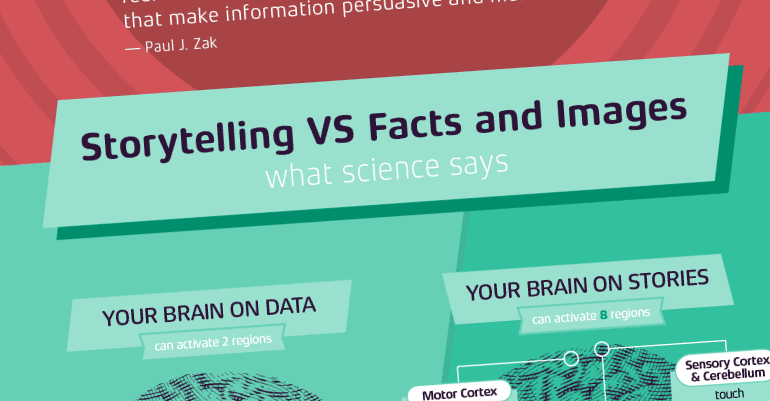
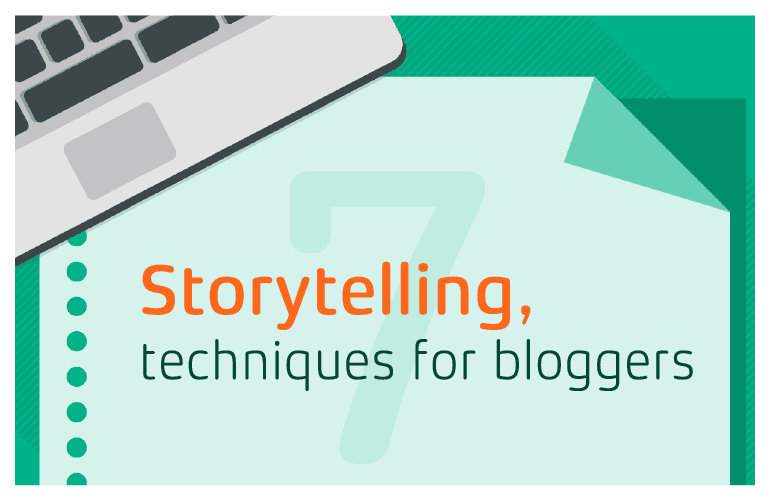
“The world isn’t just the way it is. It is how we understand it, no? And in understanding something, we bring something to it, no? Doesn’t that make life a story?”
― Yann Martel, Life of Pi
This article and infographic were created to assist bloggers and all-around publishers on the process of creative writing. Please click the image below to see the infographic or continue to read the extended version.
#Storytelling
Stories are, perhaps, our oldest way to preserve and transmit culture. A sit around the campfire listening to tales and legends seems like a really probable setting for a dawn-of-mankind prehistoric summer night as much as for next weekend’s night-out. Stories are in fact embedded in us and in what makes us human, we live in them by day, imagine our volatile and deep thoughts with them and dream in them by night. Use them for learning, communicate and getting closer to everybody and use them for our selfish alienation and personal entertainment. Without them, our own perception and experience of the world would lack coherence as they bond the physical and mental reality together, populating them with characters and sceneries that flow through a continuous life-lasting timeline.
#Why are stories so catchy and immersive?
“Experiments show that character-driven stories with emotional content result in a better understanding of the key points a speaker wishes to make and enable better recall of these points weeks later. In terms of making an impact, this blows the standard PowerPoint presentation to bits. I advise business people to begin every presentation with a compelling, human-scale story. Why should customers or a person on the street care about the project you are proposing? How does it change the world or improve lives? How will people feel when it is complete? These are the components that make information persuasive and memorable.” — Paul J. Zak
Why your brain loves good storytelling
#What does this have to do with my blog?
In the end, it all revolves around the exchange of information and final quality of the message under the receiver’s point of view. No matter what kind of media we use, in any composed, non-coded message there will be at least 2 of these elements: “Why, what, who, where, when.
These are enough for us to shape our information like a story, independently of the content addressed.
The key here is to briefly abstract from the content, identify the above subjects and treat them as they are the basic elements of any story:
 This will allow us to effectively guide our audience through different emotional paths, generating a more empathic emotional response while improving the whole reading experience.
This will allow us to effectively guide our audience through different emotional paths, generating a more empathic emotional response while improving the whole reading experience.
#A few writing basics
It’s commonly accepted that we can divide writing activity in 4 broad types:
Expository – Facts, Persuasive – Opinions, Descriptive – Poetry, diaries, Narrative – Fiction, stories
It is also safe to say that the vast majority of the blog writers and news journalists make extended use of persuasive writing when composing their stories as it effectively describes and sustains a point of view, idea; even a product or situation. (Allying the effectiveness of persuasive writing to the emotional triggering capabilities of storytelling, can get both informative and accurate text that, besides being beautiful and engaging, triggers an increased emotional response.)
Our vast literary legacy is the best place to find proven ways to tell stories, so it’s not surprising to find a huge number of ways to narrate the same chain of events. As we’re addressing a specific type of writing and content, we’ve summed up 7 simple techniques that will help the writing of the big majority of your content.
#The Techniques
#1 The Mountain or Hero’s Journey
This is probably the most common storytelling technique, it’s omnipresent from fiction writing to folklore tales and religion writing or myths worldwide since immemorial times.
It has its name from the progressive escalation in action when a new level is achieved by overpassing the previous one keeping a linear and progressive information building until the delivery of the final conclusion.
The most notorious technique derived from this is called The Hero’s Journey, where a character (the Hero), starts as a common human being faced with a great challenge, needs to abandon his life to embark on an epic journey to the unknown.Will be faced with temptations and challenges he will overcome, he will be reborn and he will grow as a being in the process. He returns safely back home with extra wisdom or a reward that makes up for all the experience.
A derived technique is called Cliffhanger, where the action is cut before any decisive conclusion leaving it unresolved and waiting for conclusion.
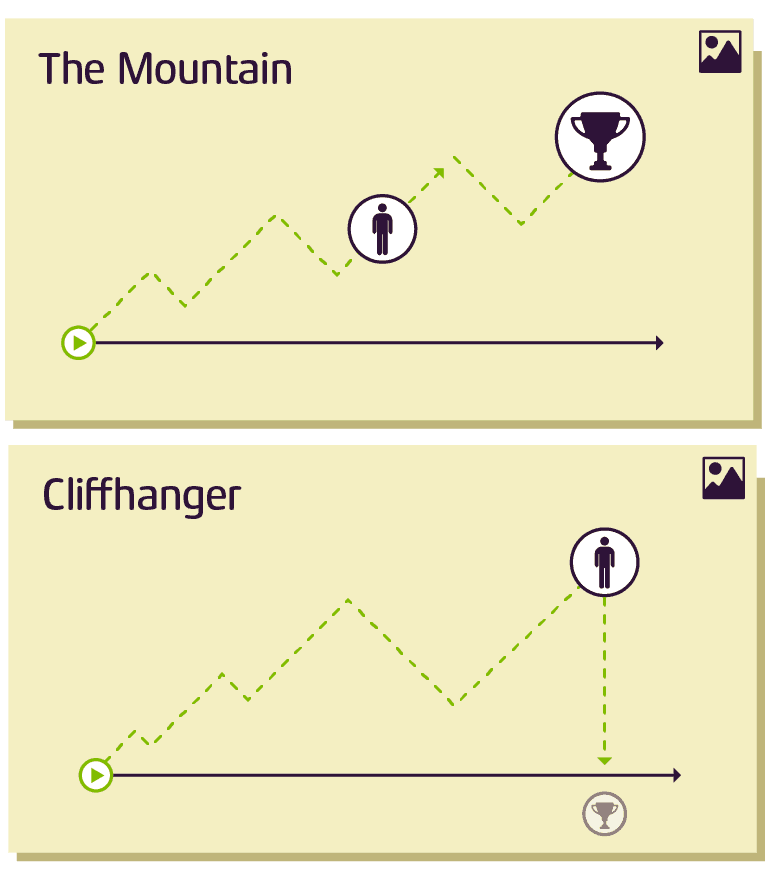
Types of articles that benefit from it:
•Personal achievement or overcoming in life stories
•Ordinary life problem solving or learning process in a non-conventional way
•Sad stories with a happy ending
•“Hooking” reader attention for posterior reading (Cliffhanger).
Pros:
•Takes audience on a journey
•Places reader in your shoes
•Presents the benefits of taking risks
Cons:
•Might not be taken seriously
•Can seem too personal or self-centered
•May leave a deceiving feeling (Cliffhanger)
As seen in:
To Kill a Mockingbird (Mountain), Star Wars, Inception (Cliffhanger)
#2 Frame story or Nested loops
Resembles an “onion skin” narrative structure, where sequential layering of the information is used to expose the core idea. The story ends with the same story it started with all the following stories finishing on the respective order they begun, with the central story separating the beginning and end of each one of them. Ex: 1,2,3,0,3,2,1. Other variations are, of course, acceptable if the conclusion remains in central position and it benefits the whole story. Ex: 1,2,3,0,1,2,3.
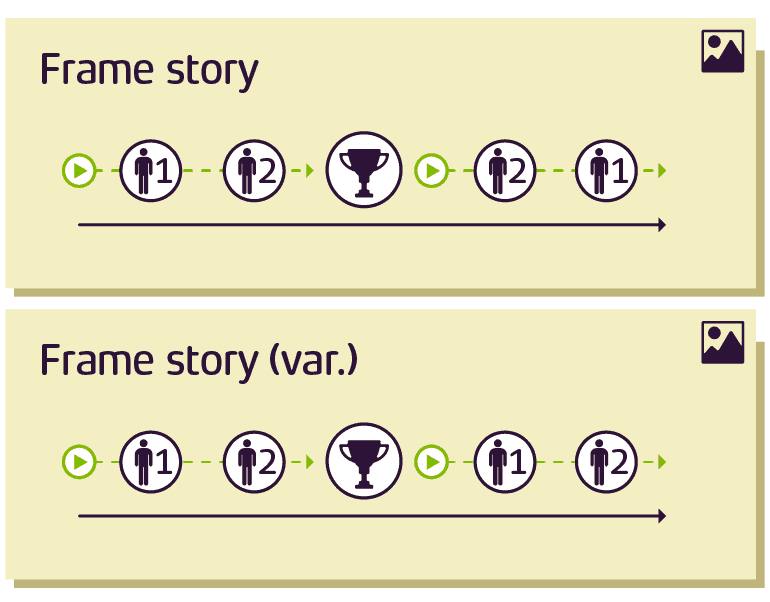
Types of articles that benefit from it:
•Articles where several people give opinion about one specific subject with respective conclusions
•Good for explaining advice or imparting knowledge on a single subject
•Text using an analogy as central subject
Pros:
•Non-linear storytelling promotes engaging
•Fits multiple opinions elegantly
•Always ends generating more information than initially given
Cons:
•May be difficult to follow
•Places core subject relevance on the second plan
•Difficult to deliver the intentional effect with divergent subjects
As seen in:
Hamlet, Titanic, The Notebook
#3 In Media res
In media res, is a latin phrase that means: in the middle of things. This is an old narrative technique that consists of starting a story in the middle of a busy sequence of events, this is expected to hook the audience that will then be eager to know both the beginning and ending of the whole story.
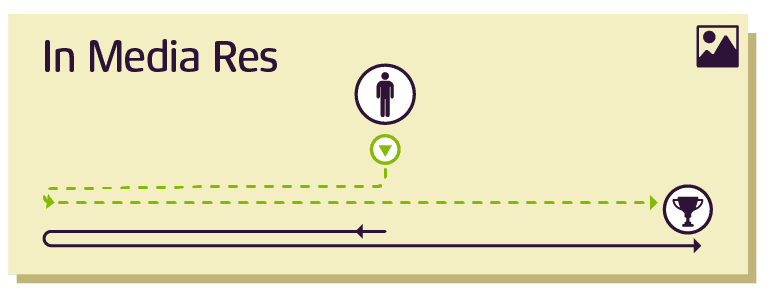
Types of articles that benefit from it:
•Short stories with odd premises
•Emergency communication
•Writing for broadcasting
Pros:
•Quickly engages audience
•Keeps attention locked on a specific subject
•Allows great flexibility in the storytelling
Cons:
•Can distract audience from the real/remaining content
•Can make reader to jump text to see conclusion
•Potentially leads to loss of interest if miscalculated
As seen in:
Memento, Forest Gump, Donnie Darko
#4 Sparklines
This technique is mostly used on speeches but also works well on written presentations. It basically consists of presenting a bilateral but linear storyline, the tension between these two poles will reveal a path to a better way, providing a solution for the conflict. The storyline follows from an introduction to a conclusion, with constant bounce between reality/ideality, and then it’s topped with a persuasive call to action that motivates change. The promise of a future reward will convince your audience that it’s worth the effort and will meet their specific needs and not only yours.
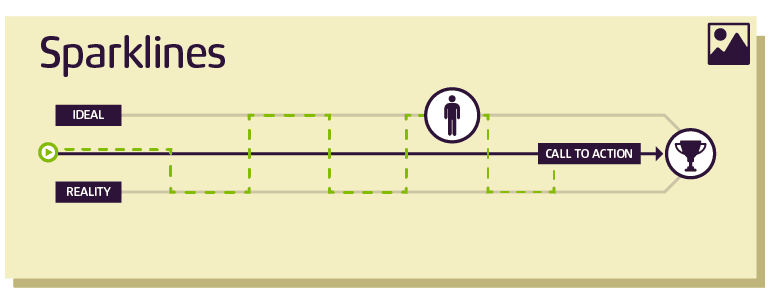
Types of articles that benefit from it:
•Awareness and fundraising content
•Personal causes or struggles
•Inspirational or motivational content
Pros:
•Creates expectations and hopes
•Highly emotional
•Prompts action
Cons:
•Might be too passionate
•Can be partial and biased
•May lead to disappointment.
As seen in:
Martin Luther King Jr-I Have a Dream Speech, Steve Jobs-iPhone Launch Speech
#5 MacGuffin
The term MacGuffin was coined by Alfred Hitchcock himself. This is a narrative plot device that focuses entirely on a final objective or motivation, sometimes giving no argument or reason for its existence or purpose of the action. All the story’s activity relies on the preconceived idea that what’s being done is correct and valid, thus, “The Way” to follow or get the original mission accomplished. It’s extremely useful due to its goal-driven nature that allows the reader to pay close attention to the process in order to successfully achieve the desired target.

Types of articles that benefit from it:
•Technical tutorials
•Self-taught techniques
•DIY projects like cooking recipes
Pros:
•Effective way to make the reader focus on an objective
•Provides a definitive solution to a problem
•Educational and didactic
Cons:
•Relies entirely on personal experience
•Only shows one or limited ways to achieve a certain goal
•Depends on relative understanding of the subject being approached
As seen in:
Lord of the rings, Indiana Jones-Raiders of the Lost Ark, Pulp Fiction
#6 Branching
Refers to the way of structuring the main story by dividing it in smaller chunks (story nodes) and presenting them one at a time, even if they occur at the same place in time, and ends after all nodes are presented with a different or common conclusion. It’s a really effective way to organize multiple stories or speakers, independently of the conclusion, and keep all the information organized. This technique can lead to multiple numbers of different structures, depending on the number of nodes we need to introduce or the way we want to present them:
Simple branching: where the story divides into two or more nodes and each of them ends differently.
Diamond Branching: when it divides but converges again for a common conclusion.
Petal: when each story node returns to the initial premise before a new one starts.
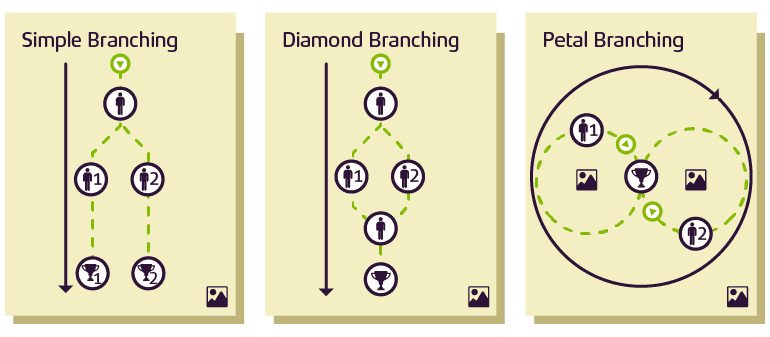
Types of articles that benefit from it:
•Debates and discussions
•Articles with multiple opinions
•Open-ended or diverging conclusion stories
Pros:
•Evidentiate interconnectedness of processes
•Relating several scenarios to one base idea
•Easy adaptation to different stories
Cons:
•Can lead to no conclusions
•Might end up being too complex
•Can be hard to implement
As seen in:
Rashomon, Lost Highway, City of God
#7 Plot twist or Red herring
Consists on the diversion from the main subject by giving the audience a false start, that is then reversed showing the real conclusion. Normally applied by starting with a vulgar and predictable story, creating a sense of security that is unexpectedly disrupted by a game-changing event. Creates a good opportunity to restart both the story and tone of writing with an already captivated audience, allowing you to finish with reinforced attention.
Can derive in Retroactive Continuity, where the story is retold after the restart, with convenient changes to deliver a determinate conclusion.

Types of articles that benefit from it:
•Innovation through failure
•Creative problem solving
•Unusual experiences
Pros:
•Powerful attention grabber
•Allows a clean reboot
•Shows benefits of a creative beginning
Cons:
•May be misleading
•Not the best choice to approach delicate subjects
•Loses time with superfluous information
As seen in:
The Sixth Sense, Fight Club, Planet of the Apes
#Sum up
The simple manipulation of narrative construction can be enough to dramatically change the way you lay the information and deliver it to your readers. Always start by identifying the plot key elements, proceed to assign their roles and animate them having in mind the kind of story you want to tell.
For the final touch, the decision of which narrative style or theme you want to use to create the overall feeling of your original story will be decisive and depends solely on the kind of project you’re running and it’s entirely up to you. The provided tools are a really effective way to approach raw information and define a basic structure to communicate it in an effective and memorable way.
Please join the fuzz and leave your comments below.
Resources
The Shapes of Stories by Kurt Vonnegut
How Pixar’s 22 Storytelling Rules Apply to Your Business
The Science Of Storytelling: How Narrative Cuts Through Distraction Like Nothing Else
The Neuroscience of Storytelling
Science of storytelling: why and how to use it in your marketing
Storytelling structure – Carnegie Mellon University, School of Computer Science
Why Your Brain Loves Good Storytelling – Harvard Business Review
5 Storytelling Techniques From Films To Make Your Brand Remarkable
8 Classic storytelling techniques for engaging presentations
8 Classic storytelling techniques for engaging presentations
Telling a Good Story: The Basics of Story Telling and Using Them for Assessment
Why How What and the strategy model – Derek Lark
“We’re all stories, in the end.”
― Steven Moffat
